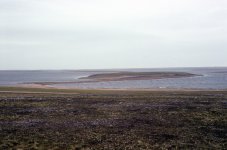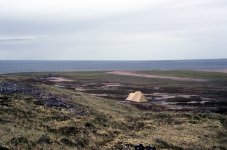When we retired, Kathleen and I moved to a one-acre property right on the ocean, on South Pender Island, between Vancouver and Victoria. We kept our canoe on the beach, 66 vertical feet below our home, and did a lot of ocean canoeing in our Royalex Mad River Explorer. I thought people here might be interested in this story that I submitted to
Beaver Tales, the monthly newsletter of our Beaver Canoe Club in Vancouver (well, actually Burnaby, but who knows where that is?). It's fairly long, but I hope you enjoy it!
You Never Know
September 10, 2004, Pender Island, British Columbia
Kathleen and I stood on the beach enjoying the early morning quiet. The summer crowds were gone, and the Labour Day power boaters had vanished toward the east. Even the packs of powerful zodiacs stuffed with hopeful whale watchers seemed to be taking the day off. Browning and Bedwell Harbours were now ours alone to enjoy.
“Say, Michael. Why don’t we just hop into the canoe and paddle over to Carol’s for a cup of coffee and some poppy seed lemon cake?”
“Sounds good to me. I’ll climb up the stairs and get our paddles. You know, though, I wonder if we really need to take all our gear. It’s only 2 km. The water’s completely calm. There’s no hint of wind – not even a gentle breeze. There’s no big boats that’ll run over us. It’s all flat water – no rapids between here and Carol’s coffee shop -- and we never capsize. Do we really need to lug our bucket of spare clothing, extra paddle, bailer and throw bag up and down these stairs? There’s not even anyone else out there to rescue. I think we’ve seen only one other canoeist all summer.”
------------------------------------------------------------------------------------------------------------
Momentary and Embarrassed Pause
------------------------------------------------------------------------------------------------------------
“We always take all our gear.
It’s a Beaver Canoe Club Rule (not to mention the Canadian Coast Guard)! That’s the way it’s done. It’s always been done that way. It always will be done that way. It’s all about safe canoeing.”
Thirty minutes later, Kathleen, I, and all our gear approached Shark Cove, where we saw a man scrambling along the low cliffs on the north side of the cove -- a place that is not particularly a good place to scramble -- a place where we had never seen anyone scramble before. We naturally decided to paddle over to have a chat. When we neared to about one hundred metres , he began to wave, somewhat frantically. It was then that we noticed a blue canoe, about 25 m off shore, half submerged, with its bow pointing straight up out of the water.
The man on shore, bleeding from multiple abrasions on his arms and legs, spoke quickly.
“I capsized about half-an-hour ago, and haven’t seen anyone since. I’ve been trying to get off this cliff, but don’t seem to be able to do it.”
The man, a tourist from Utah, had rented a very nice guest cottage just a few minutes around the corner in Shark Cove. He had been setting a crab trap from the guest canoe, equipped with an electric motor rigged up on the side of the boat, near the stern. When setting the trap, he leaned over, on the motor side, to help guide the trap downward. The combined weight of motor and man then dipped the gunwhale beneath the water, and over he went.
The canoe became entangled in the crab trap line, and the motor acted like an anchor, which explained why the canoe sat vertically in the water.
The man slumped down, still speaking quickly.
“God, I’m tired. I tried to pull the canoe free, but I couldn’t. I got exhausted so fast. The water is cold. I finally decided I had to get to shore. I barely made it. I think I would have drowned if I hadn’t been wearing a life jacket.”
Kathleen and I paddled over to his canoe and tried to work it free. It wouldn’t budge from its vertical position. We then tied one end of our
ever present throw rope to a thwart and paddled back to shore. The line played out just as we reached the cliff. Although the man tried to help us tug his canoe free, he needed to rest every few seconds. He was apparently entering the initial stages of hypothermia, even though it was a sunny and somewhat warm day.
“Why don’t you just rest. Kathleen and I will pull your canoe back to shore.”
The canoe broke free sluggishly from where it had become ensnared beneath the water. Moments later we held his canoe up against the side of the cliff. Obviously, however, we couldn’t pull a canoe full of water straight up a 45-degree cliff. Also, we couldn’t empty the canoe by turning it over because we didn’t want to lose the electric motor’s battery, which fortunately hadn’t yet fallen out.
With our
ever present bailer Kathleen easily emptied the canoe in mere minutes, and all three of us yanked boat, motor, battery, and crab trap (with 1 crab!) up onto the cliff. The man sat down to rest.
“Gosh I’m tired. Thanks a lot. I can’t tell you how much I appreciate this. You have saved my day.”
------------------------------------------------------------------------------------------------------------
Momentary and Embarrassed Pause
------------------------------------------------------------------------------------------------------------
Aw shucks. It’s nothing any good rule-minding Beaver Canoe Club member wouldn’t have done.
With everything in order, and seemingly under control, we put the man back in his canoe --an Old Town Pathfinder -- 14 feet, 10 inches long. The bow rose majestically a full metre out of the water, with the man, electric motor, and very heavy battery all in the narrow stern, which rode precariously only a few cm above the water. A certain capsize just waiting for the right time and place. Kathleen climbed into the Pathfinder’s bow to create better trim, and we headed back to the guest cottage, en route to Carol's for that cup of coffee and some poppy seed lemon cake.
When we returned 90 minutes later we again saw the man on the beach below his guest cottage, cleaning out the canoe with his wife’s help. He said he was still cold and tired from his brief encounter.
“I’m surprised,” he said. “I’m in good shape. I work out and jog on a regular basis. I’ve eaten a huge plate of hot spaghetti. I’ve got this wool sweater on. But I’m still feeling completely worn out.”
“Well, you probably know that body heat is lost something like 15 times faster in water than in air. I think you ought to just take it easy and go back inside and stay warm. You made two very good decisions today, you know. The first was to wear your PFD, even though you were going only a few minutes away from your cottage. It’s surprising how often recreational paddlers don't do that. The second good decision was to abandon your boat and gear to save yourself. Otherwise, a beautiful holiday morning and a 5-minute canoe trip could have ended very differently.”
“Thanks again, guys. I really do appreciate your help. I don’t know what would have happened if you hadn’t come along.”
You never know.


